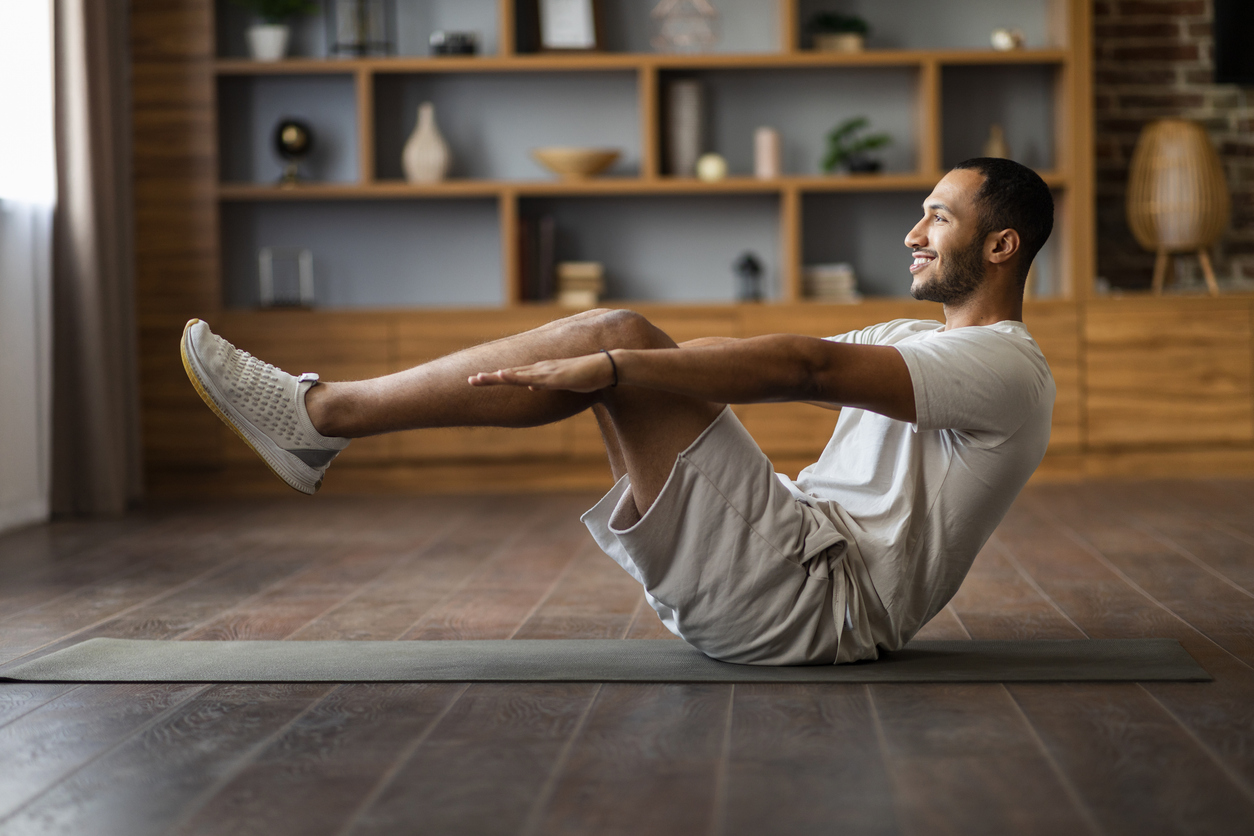
Staying fit doesn’t require an expensive gym membership or fancy equipment. With the right approach, you can maintain or even improve your fitness levels from the comfort of your home. Whether you’re looking to build strength, improve flexibility, or boost cardiovascular endurance, home workouts offer convenience, flexibility, and cost savings. In this guide, we’ll explore effective home workout strategies and how to stay fit without setting foot in a gym.
1. Bodyweight Exercises
Bodyweight exercises are an excellent way to build strength and improve your fitness without needing any equipment. These exercises use your own body weight as resistance, making them perfect for home workouts. They can target all the major muscle groups, helping you develop strength, endurance, and mobility.
Key bodyweight exercises:
- Push-ups: Strengthen your chest, shoulders, triceps, and core.
- Squats: Work your quads, hamstrings, glutes, and lower back.
- Lunges: Target your legs and improve balance and coordination.
- Planks: Build core stability and strength.
- Burpees: A full-body movement that boosts cardiovascular fitness while building strength.
Pro tip:
- Start with a circuit of these basic exercises, performing each one for 30 seconds to a minute, with minimal rest in between. As you progress, increase the duration or add variations to challenge yourself.
2. Create a Consistent Routine
One of the benefits of working out at home is flexibility, but it’s essential to establish a consistent routine to see results. Set aside specific days and times for your workouts and treat them as non-negotiable appointments. Consistency is key to improving fitness, building muscle, and maintaining motivation.
How to create a routine:
- Set a weekly workout schedule that includes a mix of strength training, cardio, and flexibility exercises.
- Start with short sessions (20-30 minutes) and gradually increase the duration as your fitness improves.
- Plan rest days for recovery to prevent overtraining and injury.
Pro tip:
- Use a workout app or a fitness tracker to schedule workouts, set goals, and track your progress.
3. Incorporate High-Intensity Interval Training (HIIT)
High-Intensity Interval Training (HIIT) is a time-efficient way to burn fat, build endurance, and increase strength. HIIT workouts involve alternating between short bursts of intense activity and periods of rest or low-intensity exercise. These workouts can be done in as little as 20 minutes, making them ideal for busy schedules.
Example HIIT workout:
- 30 seconds of jumping jacks
- 30 seconds of squats
- 30 seconds of push-ups
- 30 seconds of burpees
- 30 seconds of rest Repeat this circuit 4-6 times for a quick, effective workout.
Pro tip:
- HIIT can be customized to your fitness level. Start with longer rest periods and shorter work intervals, then gradually increase the intensity as your fitness improves.
4. Use Household Items as Weights
You don’t need expensive dumbbells or kettlebells to incorporate strength training into your home workouts. Many common household items can be used as makeshift weights, allowing you to perform resistance exercises at home.
Household items to use:
- Water bottles or milk jugs: Fill them with water or sand to use as hand weights.
- Backpacks: Load a backpack with books or other heavy items and wear it during exercises like squats or lunges for added resistance.
- Cans of food: Use small cans as light hand weights for arm exercises like bicep curls or shoulder raises.
Pro tip:
- Gradually increase the weight of these items as your strength improves, just like you would with traditional gym equipment.
5. Follow Online Workout Classes
The internet offers a vast selection of free workout classes, ranging from yoga and Pilates to cardio and strength training. Following along with a video workout provides structure and motivation, especially if you’re new to exercising at home. Platforms like YouTube, Fitness Blender, and Nike Training Club offer a variety of classes for different fitness levels and goals.
How to make the most of online classes:
- Choose classes that match your fitness level and goals (e.g., weight loss, muscle building, flexibility).
- Set up a designated workout space where you can follow along without distractions.
- Stay consistent by scheduling classes into your weekly workout routine.
Pro tip:
- If you find a trainer or class you enjoy, stick with their programs to maintain motivation and track your progress.
6. Stretch and Focus on Mobility
Maintaining flexibility and mobility is essential for preventing injuries, improving posture, and enhancing overall fitness. Incorporating stretching and mobility exercises into your home workout routine helps reduce muscle tension, increase range of motion, and support recovery after strength or cardio sessions.
Key stretches and mobility exercises:
- Dynamic stretching: Warm up your muscles before a workout with movements like leg swings, arm circles, or walking lunges.
- Static stretching: After your workout, perform static stretches such as hamstring stretches, quadriceps stretches, and shoulder stretches to improve flexibility.
- Foam rolling: Use a foam roller to release tight muscles and improve circulation. It’s especially helpful for sore muscles after strength training.
Pro tip:
- Incorporate yoga or Pilates into your routine to improve both flexibility and strength while promoting mindfulness and relaxation.
7. Use Resistance Bands
Resistance bands are an affordable and versatile addition to any home workout routine. They provide resistance during exercises, making movements more challenging and effective for building strength. Resistance bands come in various levels of resistance, so you can adjust your workout intensity.
Benefits of resistance bands:
- They’re lightweight, portable, and easy to store.
- Bands offer a low-impact way to strengthen muscles, making them ideal for beginners or those recovering from injury.
Pro tip:
- Use resistance bands to add difficulty to bodyweight exercises like squats, lunges, and push-ups, or incorporate them into upper body exercises like rows and bicep curls.
8. Try Tabata Training
Tabata is a form of high-intensity interval training that follows a specific format: 20 seconds of intense exercise followed by 10 seconds of rest, repeated for 8 rounds (4 minutes total). Tabata workouts are short but highly effective for boosting cardiovascular fitness and burning calories.
Example Tabata workout:
- 20 seconds of jump squats, 10 seconds rest
- 20 seconds of mountain climbers, 10 seconds rest
- 20 seconds of push-ups, 10 seconds rest
- 20 seconds of burpees, 10 seconds rest Repeat for a total of 4 minutes.
Pro tip:
- Tabata can be adapted to any exercise, so mix up the movements to target different muscle groups and keep your workouts fresh.
9. Utilize a Jump Rope for Cardio
Jumping rope is an excellent cardio exercise that improves coordination, balance, and endurance. It’s a simple, effective way to elevate your heart rate and burn calories in a short amount of time. Plus, a jump rope is inexpensive and takes up very little space, making it perfect for home workouts.
How to incorporate jump rope:
- Start with short intervals of jumping rope (e.g., 30 seconds on, 30 seconds off) and gradually increase the duration as your endurance improves.
- Use the jump rope as a warm-up or as part of a HIIT workout for a cardio boost.
Pro tip:
- Focus on maintaining a steady rhythm and proper form to maximize the benefits and prevent injury.
10. Stay Accountable and Motivated
One of the challenges of home workouts is maintaining motivation without the structure of a gym or group class. To stay accountable, set clear fitness goals, track your progress, and find ways to stay motivated, such as joining an online fitness community or working out with a friend virtually.
How to stay motivated:
- Set specific, measurable fitness goals (e.g., complete 3 home workouts per week or run 2 miles without stopping).
- Use fitness apps or a journal to track your progress and celebrate small wins.
- Share your fitness journey with a friend or family member to stay accountable.
Pro tip:
- Reward yourself when you reach your goals, whether it’s with a new workout outfit, a relaxing self-care day, or treating yourself to a healthy snack.
Staying fit without a gym membership is entirely possible with the right mindset and strategies. By incorporating bodyweight exercises, HIIT, resistance bands, and online workout classes, you can create an effective fitness routine at home. With consistency, creativity, and a focus on your goals, you’ll be able to maintain a healthy lifestyle and reach your fitness targets from the comfort of your own space.







